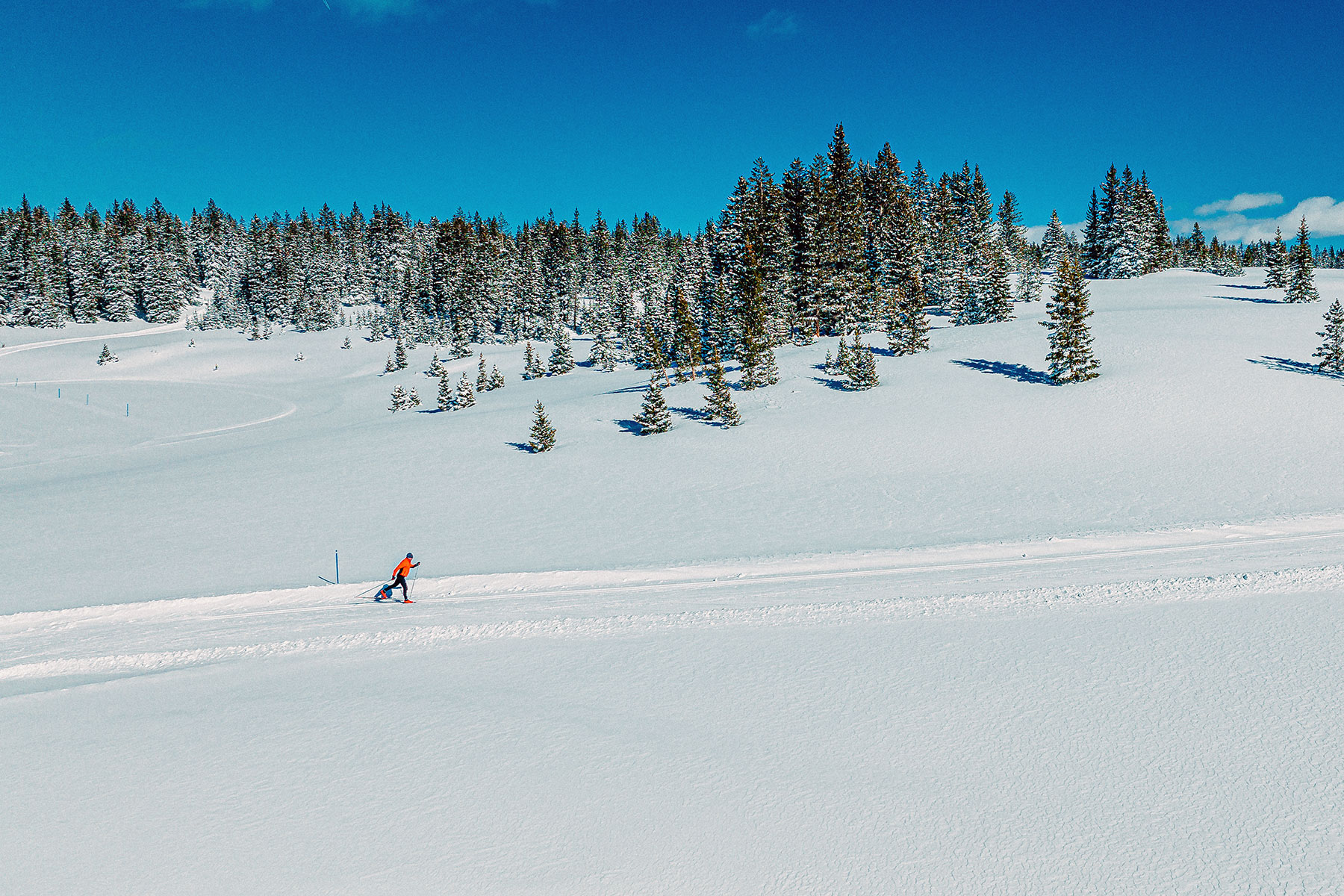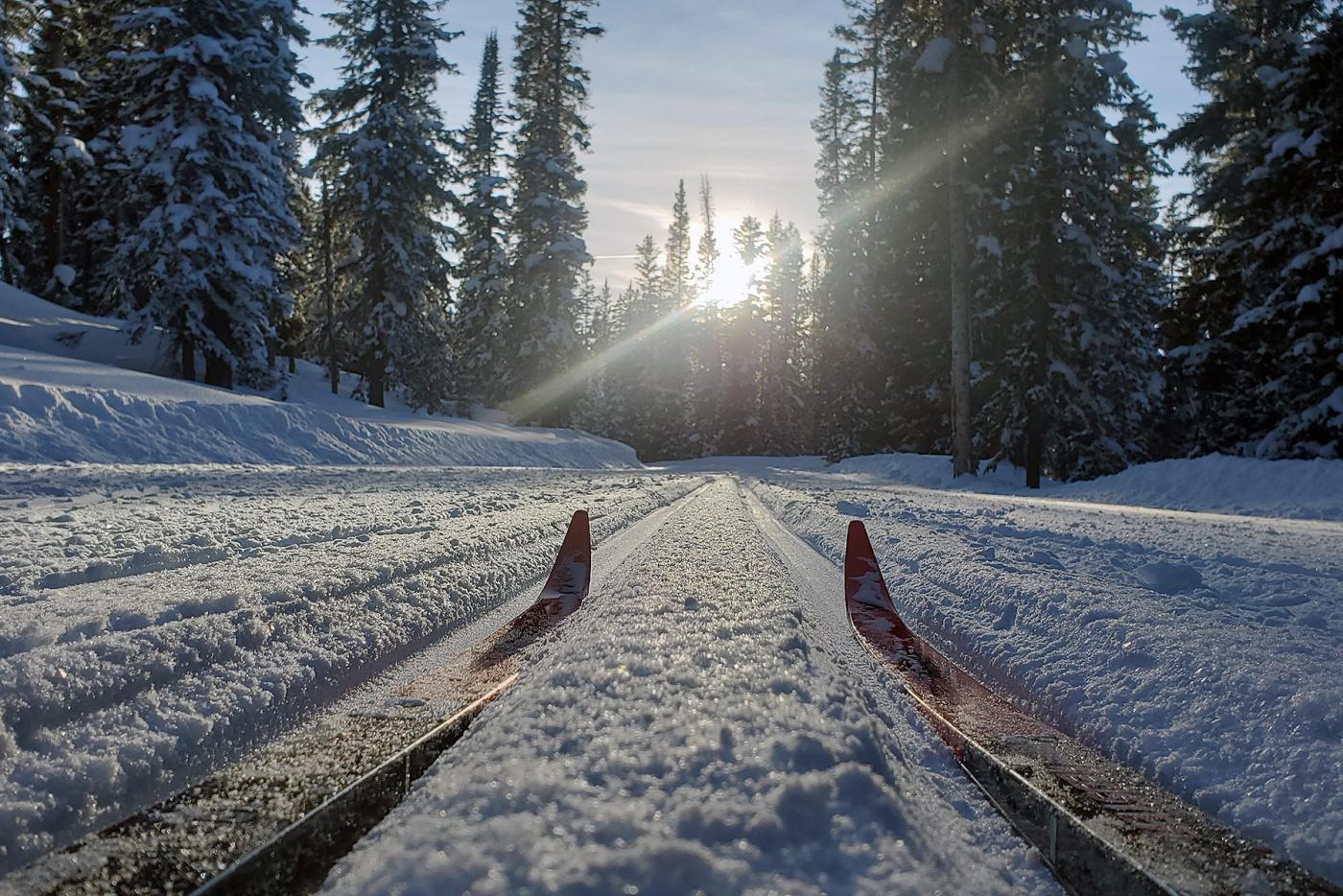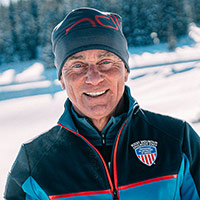Classic Ski Flex, Camber and Structure
For classic cross country skis to perform well, you should consider three factors:
- Ski flex: needs to be correct for the skier’s weight and ability level
- Ski camber: needs to be appropriate for the snow conditions
- Ski base structure: should be specific to the typical snow temperature and moisture content of where you ski
For beginner to intermediate classic skier, skier weight and ability level are the most important factors. For intermediate to advanced skiers, typical snow conditions at their favorite ski areas or races play an important role too.
Ski Flex
The ski flex (tension) must be appropriate for skier's weight and skill level.
The ski flex is three things:
1. Cross country skis have a certain amount of pre-tensioning that creates the camber (bowing up) in the ski. The pre-tension is the distance between the ski and the snow surface, without any pressure (weight) on the ski.

2. When the skier steps on the skis and stands evenly on both feet they create a residual tension, which is the small gap left between the ski and the snow surface underneath the binding area.

3. The camber pressure is the force necessary to press the ski down on a flat surface until only a 0.2 mm gap in the binding area between the skis and and the surface can be measured. In other words, the camber pressure is the force necessary to connect the ski with the snow. The 0.2 mm gap left underneath the binding area is needed for the layers of grip wax or the skin.

Ski manufacturers provide reference tables for choosing the correct ski length for the skier's weight, which ensures that ski will flex just right:
- For propulsion: a skier would apply force to one ski to cause the ski's grip zone to come in solid contact with the snow allowing the skier to push off from that ski;
- For gliding on both skis: a skier stands on both feet with their weight evenly distributed over both skis allowing the ski's grip zone to hover just a bit above the snow preventing the ski from gripping;
- For gliding on one ski: a skier glides with their weight on one ski and while the ski's grip zone is in the snow because the ski is flattened, the ski glides with minimum resistance because the ski isn’t over flexed (bowing down).
If you are a beginner skier and your weight falls near the low number of the recommended weight range for the ski, select the ski length for the next lower weight range (a shorter ski).
Recreational classic skis typically come in couple flexes that cover broad weight ranges.
- Medium
- Hard


Performance-oriented classic skis from Atomic are available in 4 flexes.
- Soft
- Medium
- Hard
- Extra Hard
To select length and flex for your selected ski model, use the sizing chart for the weight range that matches the relevant ski length.
- Add 20 to 30 cm to your body height and look for the relevant ski length in the red sections. The general rule is: the more skilled you are, the longer your ski can be.
- Search the grey fields for the weight range that matches the relevant ski length. The blue fields indicate which flex you should choose. The flex is always derived from the skier’s body weight/height relationship.


Example of how to use the ski recommendation chart:
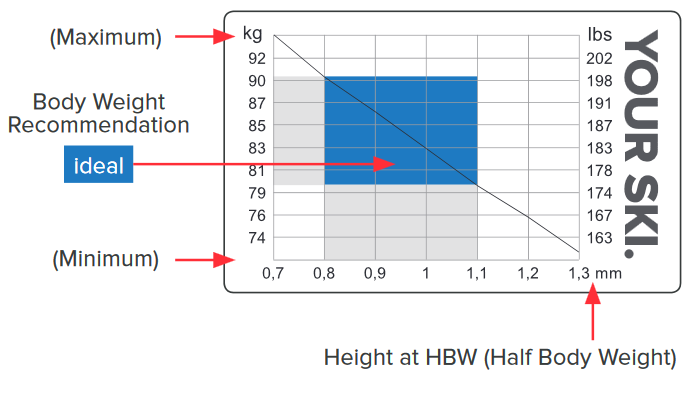
John weighs 145 lbs (66 kg) and is 5'7" (170 cm) tall. He is an intermediate skier and is going to buy Atomic Redster C9 Carbon Skintec classic skis. He would add 25 cm to his height of 170 cm to arrive at the recommended ski length of 195 cm. He would pick from the chart the closes length increment of 197 cm. The recommended flex for his weight would be Soft. The recommended ski for John: 197 cm Soft.
For example, Atomic skis come with stickers that show recommended skier's body weight range for that pair of skis.
This sticker includes a color coding for different conditions: cold (blue), universal (yellow) or warm (red). The sticker shown below is for a cold ski which is recommended for skiers between 72-94 kg, perfectly suitable for 80-90 kg.
Consequences of too much tension in the ski: Pushing off becomes almost impossible as the skier cannot compress the ski enough for the grip zone to make contact with the snow. Additionally, the skier glides on tips and tails of the ski resulting in poor ski control and in extra resistance through friction in cold/soft snow conditions.
Consequences of not enough tension in the ski: The ski is slow due to the skier compressing the ski through the camber, thus resulting in permanent contact of the grip zone with the snow.
If you are buying used skis, you should have a professional shop help you determine if the skis are properly flexed for your weight. If you have no access to a competent shop, you can do a paper test. Here's how to do a paper test:
Whenever possible, use a competent ski shop to determine the best ski flex for your weight and ability. You can also search the internet to find the flex chart for the year, make, and model of your skis.
The correct flex of the classic skis allow for grip during the push-off phase and for minimal resistance in the glide phases.
Ski Camber (Cold, Universal, Plus)
Snow conditions should dictate the desired camber of the ski.
Snow at high altitude in states such as Colorado, Utah or Wyoming is cold most of the ski season. But isn't all snow cold? Yes, but the snow surface temperature varies and is controlled by the air temperature above. The colder the air above, the colder the snow layers near the surface will be, especially within the top 30-45 centimeters (12-18 inches). Since many cross country ski areas in those states are at altitudes above 6,000 feet (> 1,800 m), the air temperature is very low (= -20F/-6C) and very dry most of the winter. Cold and dry snow is characterized by sharp crystals that create friction with the ski base making the ski slower and harder to maneuver.
Cross country skis bow upward in the middle, and that upward bowing of the ski is called the ski camber. A low camber ski has long contact zones with the snow while a high camber ski has short contact zones.

Ski Camber for Cold and Dry Snow
For a ski to be as fast as it can be and easy to maneuver in cold, dry snow, it should generally have a low camber and a relatively long area of contact in the tip and tail sections. The same amount of friction spread over a larger area (longer contact zones) translates into less friction per square inch and therefore faster glide in dry snow.
Ski Camber for Wet and/or Dirty Snow
In snow that has a high moisture content ("wet snow") you would want a high camber ski that will fight suction and thus remain fast and maneuverable. A low camber and more contact between the ski base and the snow would result in more suction and more opportunity to pick up dirt, creating more friction and more suction. The suction effect would lead to the ski braking. Also, dirty snow, even when cold and dry, creates the same braking effect as the wet snow. A low camber ski would result in more opportunities for dirt to attach itself to the ski base, making the ski slow due to the added friction. The dirt in the ski’s base structure affects the hydrophobic nature of the base material. In short, high-camber skis should be used in wet snow to fight the suction effect and/or to reduce friction in dirty snow. In short, high camber skis should be used in wet snow to fight the suction effect and/or to reduce friction in dirty snow.
Ski Base Structure
Snow conditions should dictate the structure of the ski's base (its underside).
Snow at high altitude is also drier than in other states most of the ski season. The difference between "wet snow" from "dry snow" is the snow-to-liquid equivalent ratio. The liquid equivalent of snow equals the amount of liquid is derived from the snow once it has melted. When your ski glides on snow it melts a microscopically thin film of water, which is what the ski glides on. If there is too much water your ski will act a bit like a suction device with the snow's surface, slowing the ski down. If there is too little water forming between your skis and the snow, the friction will also slow down your skis.
Ski Structure for Cold and Dry Snow
For a ski to be as fast as it can be and easy to maneuver in cold, dry snow, its base finish should have a structure designed for dry, abrasive snow crystals. Fine and smooth ski base finish will prevent the sharp-edged snow crystals from snagging the base and thus slowing creating a braking effect on the ski. Such structure is achieved with stone grinding, which is a process where a ski grinding/tuning machine uses special rotating stones to remove sealed base material, flatten the base, and apply final structure to the ski base surface. For skis that will be used in cold, dry snow, the final structure will be very smooth.
Ski Structure for Wet and/or Dirty Snow
For a ski to perform well in wet snow conditions it needs to have a high camber with a wet/warm structure on the base to minimize the contact with the wet snow.
A cold snow structure in the base of a cross country ski.
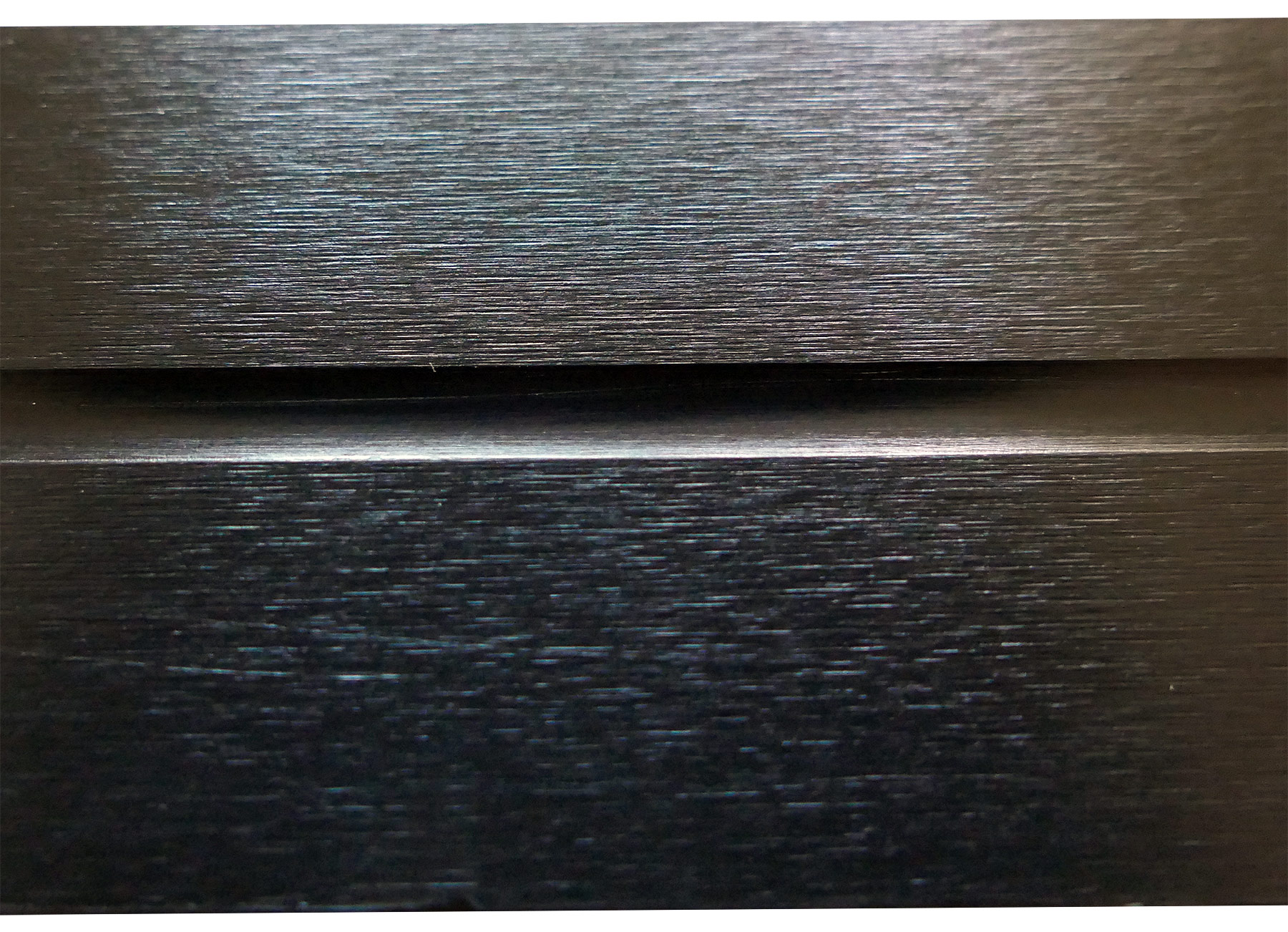
WINTERSTEIGER Automatic Service Station performing a base grind on cross country skis at the Racer's Edge in Breckenridge, Colorado.
Ski Weight
Weight of the skis plays an important role for skiers who seek speed or ski long distances, or otherwise seek high performance in their skiing. Skis that are really light in tip and tail minimize their swing weight. The result is a lower mass inertia making the pendulum motion of the leg in diagonal stride and kick double pole techniques less tiring. In general, overall lighter skis are less tiring and more maneuverable allowing skier to ski faster and farther.
